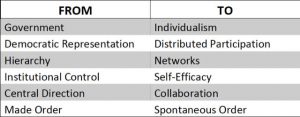We have reached the point where a majority of Americans express negative opinions about a wide range of institutions.
58% believe the federal tax system is unfair. 63% believe the national news media have a negative effect on the way things are going in the country. More people have a negative point of view about banks and other financial institutions than a positive one. 65% of those who describe themselves as conservative have a negative view of the effect of colleges and universities. 51% say they trust what the current President says less than previous Presidents. 54% have an unfavorable view of the Republican Party and 51% have an unfavorable view of the Democratic Party. 62% have an unfavorable view of Congress. (All of these data come from the wonderful Pew Research Center.)
Institutional Decay.
In The Great Degeneration, historian Niall Ferguson recognized institutional decline and predicted profound consequences: the breakdown of our civilization.
Unless, he said, there is a heroic commitment to radical reform.
Fat chance, you might think. Sclerosis is the normal effect of institutional decay, rather than a spark of action. Decayed Institutions become rigid structures of top down control and suffocating blankets of intermediation.
Institutional Innovation.
But there can be great hope. In the past, Institutions evolved at a glacial pace. They changed over generations. With the advent of new technologies, change can come much more rapidly – not through faster evolution, but through innovation. The new Institutions will not be designed by committee, they’ll emerge as a result of inverse design – the bottom up process of free individuals autonomously generating totally new structures.
Here’s a very brief, topline summary of the general principles that will stimulate this inverse design process.
From Government to Individualism
The most reactive and restrictive Institution of all is government. Its goal is control. As Individuals become increasingly augmented by technology, and increasingly able to interconnect with people, knowledge and resources all over the globe without government restrictions (on blockchains, for example), the restrictive control of government will dissolve. Whatever Institutions emerge will be user-centric, not government centric.
From Democratic Representation to Distributed Participation
Democratic representation doesn’t work, and it’s one of the reasons our political institutions don’t change. 535 members of Congress can’t and don’t represent the dynamic and multi-hued viewpoints and innovative behaviors and groundbreaking ideas of 320+ million Americans.
Technology is revealing the power of distributed systems in which millions can participate actively and develop dynamic collaborative decision-making. Distributed participatory systems will replace democratic voting and representation systems.
From Hierarchy to Networks.
Hierarchy originated in the military. Generals (and monarchs) gave orders, which were passed down through layers of command to the common soldier, who did what he or she was told, and often died or was injured or maimed as a result. From those origins, hierarchy invaded business corporations and other organizational structures.
Today, there is broad recognition that hierarchy is inefficient in the use of talent, information and ingenuity. Collaborative interconnected networks are replacing hierarchy. From these networks, new institutional arrangements will emerge.
From Institutional Control To Self-Efficacy.
Institutions exist to modify individual behavior. Eventually, they entrench themselves so that individuals can do nothing without them. We need a license to pursue a profession, a lawyer to make a contract, a banker to get a loan, a teacher or a school to introduce us to knowledge. No longer.
Individuals can now chart their own course, devise their own education, conduct peer-to-peer transactions all over the world, execute smart contracts and make or receive direct loans. Self-efficacy is becoming the new standard.
From Central Direction to Collaboration
We don’t need to be told what to do by someone older, or smarter or in a position of power. Increasingly, we don’t have to. We are naturally collaborative in our efforts to achieve both individual and shared goals. Technology platforms that enable us to reach, share with, collaborate with and transact with anyone anywhere empower us to manage our own projects, our own lives, our own enterprises and our own collaborative teams. Central direction only slows things down and limits the options that can be pursued. It’s going away.
From Made Order To Spontaneous Order
Spontaneous order is the happy result that emerges as the best outcome for all participants when there is no government, no hierarchy, no control and no central direction, just a few general rules that apply to everyone equally. When systems are left to operate under these conditions, order emerges. That’s what the term inverse design means – the act of not designing / controlling, coercing or directing has the consequence of allowing the best result for all participants to emerge naturally from their individual behaviors.
General Conditions For Not Designing.
None of the attributes listed here represent a solution. They are simply new general conditions. From here, creative and entrepreneurial individuals will act to improve their circumstances within this new context, and institutional innovation will emerge. Inverse design is not designing.










